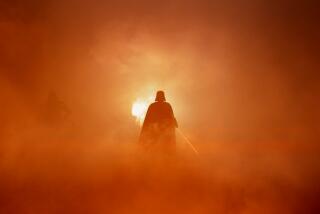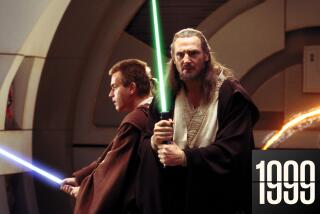The Story Behind ‘Episode I’
- Share via
For 21/2 years, first-time filmmaker Jon Shenk followed one of Hollywood’s most enigmatic and influential figures during the making of “Star Wars: Episode I The Phantom Menace.”
The result, a one-hour documentary called “The Beginning,” about George Lucas and the making of his blockbuster prequel, is arguably more entertaining than the auteur’s $115-million epic. (Comparing them is easy because the one-hour documentary is available only on the recently released DVD version of “Phantom Menace.”)
For film lovers, “The Beginning” is the rarest of inside looks at mega-budget moviemaking, as Lucas aims to push the envelope of technology and ambition. You get to sit in on budget meetings, casting sessions for the Anakin Skywalker character, early storyboard discussions and the testing of animatronic characters.
But for fans of “Star Wars,” “The Beginning” also sheds light on why “Phantom Menace” was, as one recent re-review put it, “not a very good movie,” criticized as having a weak plot, cardboard characters and that annoying Jar Jar Binks.
“The Beginning” shows that most of the passion and energy for “Phantom Menace” went into the film’s technical side.
Otherwise, the director, who rarely grants interviews (and even then doesn’t say much), reveals himself to be an inwardly focused visionary--some might even say a cold fish. Meeting his new assistant director as shooting gets underway in Britain, Lucas--in plaid shirt and poker face, neither of which seems to change throughout the film--mumbles only, “Sometimes I say ‘cut,’ sometimes I forget.”
Then there’s the moment after Natalie Portman, playing Queen Amidala, delivers a single line in an expressionless monotone, her face nearly hidden beneath Kabuki-like makeup. Walking away after a couple of takes, Lucas pronounces himself thrilled with her performance.
Documentary maker Shenk was hired a year out of Stanford University film school to shoot footage of “Phantom Menace” for the 20th Century Fox publicity department. The footage was used on the “Star Wars” Web site before the film’s release, and Lucas had a vague notion about using it for an educational project. Shenk kept pushing to make a film.
“The idea was to shoot first and ask questions later,” the 32-year-old filmmaker says over lunch in Beverly Hills. “My sense was, ‘This is an amazing opportunity to make a great film.”’ But Lucas was too busy making his movie to give the idea much thought. So Shenk just shot and shot--about 600 hours of footage.
Then, last February, 18 months after parting ways with Lucas and company, Shenk got a call from Skywalker Ranch, Lucas’ vast production facility, inviting him to make a documentary to be included on the “Phantom Menace” DVD.
By that time, he knew which shots he wanted in the film and edited the footage into “The Beginning” in just two months.
Some of the moments Shenk captured are undeniably nifty: Ewan McGregor’s unbridled glee at picking out a handle for his light saber, or Steven Spielberg touring the set at dusk with his old pal Lucas, checking out the parts on a life-size android.
Shenk also catches the human drama of large-scale filmmaking, when a sudden huge storm in Tunisia demolishes three months’ worth of set-building. The anguish on producer Rick McCallum’s face as he reviews the damage is poignant.
They Live to Serve George Lucas’ Vision
Throughout, what’s clear is that all the hundreds of technicians, the millions of dollars, go to serve Lucas’ vision alone. No one ever questions the master. (Lucas also had final approval over “The Beginning,” although Shenk says he didn’t change anything significant.)
Asked what he thinks of “Phantom Menace,” Shenk, now at work on a documentary about orphans from Sudan, is deftly polite. “The thing I’m most struck by is how groundbreaking it is as a visual work,” he says, recommending watching it without the dialogue. “I have a real appreciation for that because I got to see how it got made.”
He adds something else you couldn’t necessarily tell from the finished result: “There was a quasi-religious-like feeling of working on ‘Episode I.’ It was like working on a new chapter of the Bible.”
More to Read
Only good movies
Get the Indie Focus newsletter, Mark Olsen's weekly guide to the world of cinema.
You may occasionally receive promotional content from the Los Angeles Times.










